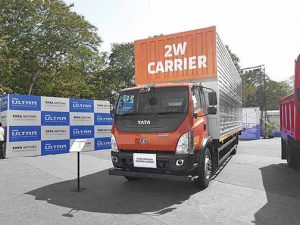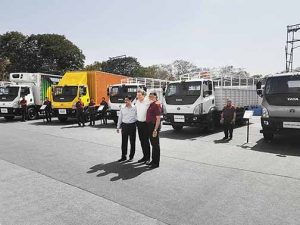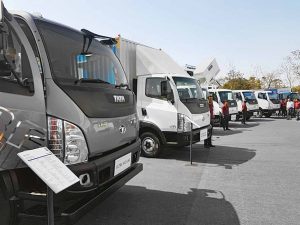Tata Motors has introduced the entire range of Ultra Trucks in the Intermediate and Light Commercial Vehicle (ILCV) segments.
Story by:
Bhushan Mhapralkar
Seeding 3000 units in the market, Tata Motors has introduced the entire range of Ultra trucks corresponding to the Intermediate and Light Commercial Vehicle (ILCV) segments. Amounting to a GVW range of seven to 16-tonnes, the trucks will address 50 applications, including two-wheeler carriage, cement, poultry, e-commerce, construction, agricultural supply chain, municipal applications and more. Comprising of 14 variants, priced in the range of Rs.10 and Rs.25 lakhs, the trucks are powered by a 125 hp three-litre, and a 210 hp five-litre Turbotron series common-rail turbo-diesel engine with EGR after treatment system. Both the engines are new and are supporting a truck design that boasts of stylish, world-class cabins (there are three types – day, wider and sleeper) that meet the world standards (European safety norms) and some of the future requirements as well. Laced with modern design elements like clear lens lamps, the cabin of the Ultra flaunts a modern and ergonomically well-arranged interior as well. Offering benchmark levels of visibility, safety and driving comfort, the walk-through cabins of the Ultra range offer sufficient storage capacity and provision for the fitment of various accessories. Hydraulically tiltable up to 45-degree to gain access to the engine below, the cabins of the truck range are designed to offer fatigue-free driving for long hours. Capable of meeting global trucking standards of emissions, safety and features – tested and homologated into various geographies (like South Africa, Malaysia, Philippines, Indonesia and other markets) outside India, the Ultra range of trucks promise to deliver superior performance, superior payload, industry-leading mileage, and significant productivity gains from among the lowest total cost of ownership.
Highly modular in nature with a wheelbase that varies from 3.3 m to 6.8 m depending on the variant (whether it is the Ultra 1518/53 24 ft. container version, Ultra T.7, Ultra 814 or the Ultra 1014) under consideration, the truck could be had with a five-speed, six-speed or an auto transmission. The cabin width ranging from 1.9 m to 2.1 m depending on the cabin type, the Ultra range of trucks, according to Girish Wagh, Head – Commercial Vehicles, Tata Motors, will address the changing needs of end users, fleet owners and drivers through superior earning potential, low cost of operation and timely delivery of goods. Aiming at a market that clocked 85,000 units in FY2016-17 and grew to 105,000 units in FY2017-18, the Ultra range of trucks have been cleverly structured at certain stages such that the 10.3-tonne payload model overlaps into the next segment. Expected to help Tata Motors to maintain traction in the ILCV segments by clocking a growth of 37 per cent against the industry growth of 25 per cent, the Ultra range of trucks are manufactured at the same plant at Pune where the legendary Tata 407 LCV was commissioned in the early 80s according to Wagh. Averred Wagh, “The Tata 407 created a completely new segment and revolutionalised trucking in India. Made at the same location, the Ultra marks a significant step forward.” Drawing attention to the positive feedback received from users of Ultra trucks that were seeded, Wagh revealed, “Every Ultra truck offers higher earning potential at every tonnage point.”
Quite modular in nature, and backed by a three-year and three-lakh warranty, the Ultra range of trucks, offering longer deck lengths and higher payload capacities, comes with power steering system and front parabolic suspension. With an LNG version on offer too, albeit in the form of Ultra 1412 (powered by a 120 hp engine mated to a five-speed gearbox), Tata Motors, according to Guenter Butschek, CEO and Managing Director, is looking at the Ultra range of trucks to be a disruptive force in the market. “With an emphasis on innovation, the Ultra range of trucks,” averred Butschek, “are about class-leading TCO, modular approach and customisation.” The two (DOHC and SOHC) Turbotron engines of the Ultra truck range are claimed to be future ready and scalable to meet BSVI emission norms. Considering the aggregates that have gone into the making of the Ultra truck range, it marks a significant step forward. How soon, or the manner in which the Ultra trucks change the market dynamics in the ILCV segments will make for an interesting development.






















